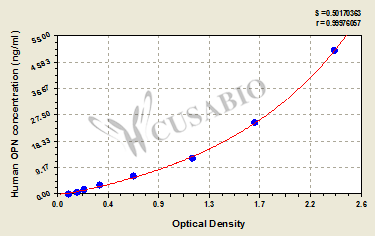The Human Osteopontin (OPN) ELISA Kit is a powerful tool for researchers in the field of cancer. This quantitative assay measures levels of OPN, a protein involved in the regulation of bone remodeling and implicated in various diseases including cancer(tumor),bone metabolism, immunity, growth and development.
With a detection range of 0.78 ng/mL-50 ng/mL and a sensitivity of 0.195 ng/mL, this ELISA kit can detect low levels of OPN with high accuracy. It can be used with a variety of sample types, including serum, plasma, urine, and tissue homogenates, making it a versatile tool for research.
The assay principle is based on the sandwich method, where a monoclonal antibody specific to human OPN is pre-coated onto a microplate. The sample is added, and any OPN present in the sample binds to the antibody. A biotinylated polyclonal antibody specific to human OPN is then added, which binds to the OPN-antibody complex. Finally, streptavidin conjugated to horseradish peroxidase (HRP) is added, which binds to the biotinylated antibody. The HRP produces a colorimetric reaction in the presence of a substrate, which can be measured at a wavelength of 450 nm.
The assay can be completed in as little as 1-5 hours and requires a sample volume of only 50-100ul, minimizing the amount of sample required for analysis. The kit includes all necessary components and can be used with standard laboratory equipment.
With 12 citations, this kit has been validated by the scientific community and is a trusted tool for cancer research. So, whether you are studying the role of OPN in cancer progression or investigating potential therapeutic targets, this Human Osteopontin (OPN) ELISA Kit is an essential addition to your research arsenal.






